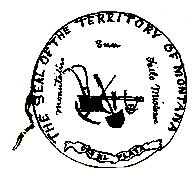State Seal
Updated: August 10, 2020

Montana's first official symbol, its seal, has had a fascinating history. A Montana Territory legislative committee initially designed a seal in 1865. Francis M. Thompson chaired the committee and had what passed for expertise in the seal design business. He had engraved seals for the first mining districts on the ends of ax handles. Even he had to admit his work was not the most artistic, but it was the best at hand.
The special committee felt a seal should include all the essential elements in Montana's economy and future. A plow, shovel, and pick would illustrate agricultural and mineral wealth. Surrounding these would be mountains, from which Montana took its name, the sun, and the Great Falls of the Missouri River. Interspersed on the field, delegates specified trees, buffalo, and other wild animals then in abundance. The seal would be two inches high and surrounded by the words THE SEAL OF THE TERRITORY OF MONTANA.
As a territorial motto, committee members favored "Gold and Silver." Someone thought the phrase would be nice in Spanish. The rest agreed. Unfortunately, no one knew Spanish very well and the committee's recommendation to the Legislature suggested "Oro el Plata." Someone caught the error later and made it grammatically correct: "Oro y Plata."

To accompany the report, Thompson drew a crude sketch and submitted both to the Legislature on February 4, 1865. (Thompson's original hand drawn design is preserved in the Montana Historical Society Library.) During formal debate, a few council members suggested "El Dorado," meaning "the place of gold," as a more fitting motto, but the special committee's recommendation prevailed. On February 9, 1865, both houses passed the measure and Governor Sidney Edgerton signed it into law. Montana had its first symbol.
Such a crude sketch as Thompson's would not do for the official seal, of course, but no one in Montana at the time could engrave it properly. Governor Edgerton delegated his nephew, a young lawyer named Wilbur Fisk Sanders, to have a seal made in the "states."
Sanders contacted the necessary parties and in the spring of 1866 delivered the official seal. Because the resolution failed to specify tree and wild animals (Sanders did remember buffalo), the engraver produced a more simplified version, complete with a single buffalo on the opposite bank of the Missouri River.
Over the years alterations in the seal took place. An 1876 edition removed the buffalo and added clouds. In 1887, the Legislature authorized a replacement for the worn seal and the engraver returned an altered plate. The mountains were different, the clouds were gone, trees had sprouted where buffalo once roamed, and the sun had shifted position, setting in the west instead of rising in the east.
After Montana became the 41st state on November 8, 1889, officials continued to use the territorial seal until 1891. That year state Senator Cornelius Hedges proposed a radical redesign:
"On the outer margin…the words 'The Great Seal of Montana,' and in smaller letters, connecting the ends of the foregoing words, separated therefrom by a scroll, and underneath the central design, the motto 'Sub Lege Libertas.' The foregoing marginal inscription shall be separated from the central device by a row of 41 stars, in the central line of which at the top shall be the figures '41' and at the bottom, the figures '1864-1889.'"
"The central design shall represent the sun rising over mountain peaks for a background, and to the left in the foreground shall appear as receding the Indian and buffalo with other wild game over a sage-brush desert, while on the right shall appear as entering the field, the emigrant wagon and stage-coach, followed by a rail-road train - also a miner with pick and shovel, the mouth of a tunnel and a quartz mill and smelter; a stream of water, a waterfall, a reservoir with water diverted over an irrigated field, also cattle, horses and sheep feeding on the foothills."
Other senators added the traditional pick, shovel and plow, plus a mule train, a school house and a shepherd's crook to the proposal. House members opposed the changes, saying Montana would need a seal ten times larger and the proposal died.
Finally in 1893, Governor John E. Rickards pushed for an official "state" seal. The Legislature agreed to stay with the old design, just deleting "Territory" and adding "State" and increasing the overall diameter from two to two and one-half inches.
G.R. Metten, manager of the J. Steimmetz Jewelry Company of Helena engraved the new seal for the state of Montana for $20. He made radical alterations in its design: reversed the flow of the Great Falls and the Missouri River, moved the sun back to its rising position, redesigned the mountains and transplanted the trees.
Subsequent engravers have taken minor liberties with the seal, but its general form remains unchanged from the design of G.R. Metten. Around the turn of the century there was some sentiment to change the state motto from "Oro y Plata" to something less related to money. The effort achieved attention in the press, but not serious consideration by succeeding Legislative assemblies.
Years later, Governor J. Hugo Aronson formulated a fictitious seal for use on his re-election campaign posters in 1956. This modification included cattle, shocks of grain, and an oil derrick to represent those aspects of Montana's economy, complementing the plow, the pick, and the shovel.
Governor Aronson's campaign succeeded, but his effort to change the seal was only jest. Montana's official seal remains today, embodying most of the elements Frances Thompson sketched out in 1865, in slightly altered form, thanks to the liberties of G.R. Metten.
Special Acknowledgements to: Montana Historical Society, Rex C. Meyers and Norma B. Ashby
Updated: August 10, 2020

